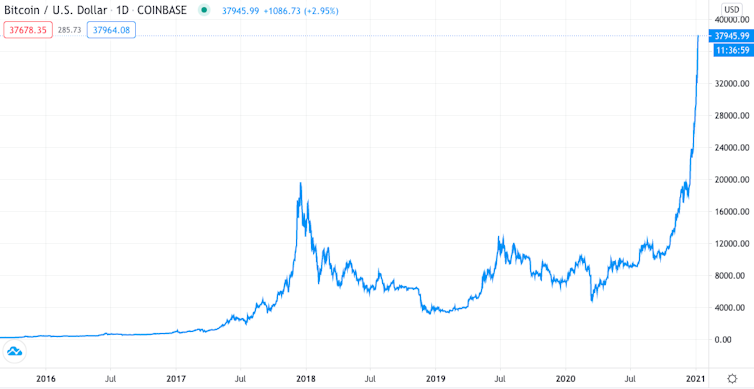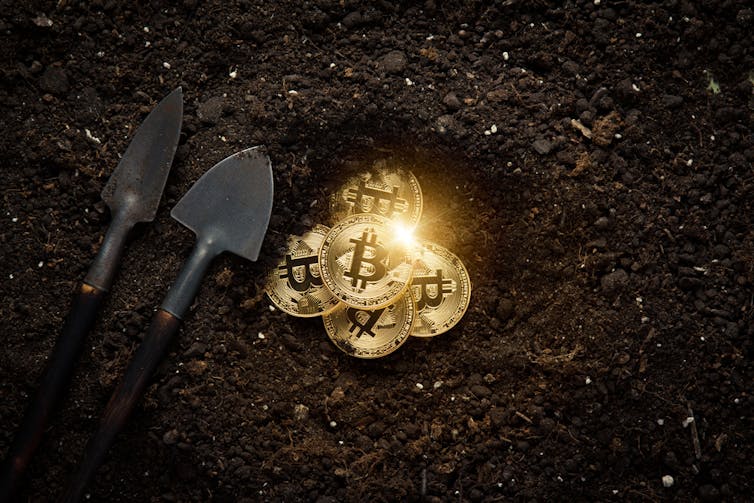
Bitcoin achieved a remarkable rise in 2020 in spite of many things that would normally make investors wary, including US-China tensions, Brexit and, of course, an international pandemic. From a year-low on the daily charts of US$4,748 (£3,490) in the middle of March as pandemic fears took hold, bitcoin rose to just below US$30,000 by the end of the year.
Since then it has climbed to all-time highs above US$38,000, making headlines day after day and driving up the prices of other cryptocurrencies at the same time. So what has driven this huge price appreciation and is it different to the bubble of 2017?
Bitcoin/US$ price 2016-21

One reason for the massive price rise is that there has been a big influx of investors from large-scale institutions such as pension schemes, university endowment funds and investment trusts. This was not the case during the last bull market in 2017, in which the bitcoin price rose about 20-fold to almost US$20,000, only to slide back to the low US$3,000s a year later.
In 2017, the cryptocurrency ecosystem was dominated by individual retail investors, many of whom were attracted to bitcoin’s scarcity and the fact that it stood outside the global financial system. The 2017 bull market had all the signs of a classic financial bubble and investors who were buying in “fear of missing out” (FOMO).
The move mainstream
This time, big names such as billionaire investor Paul Tudor Jones and insurance giant MassMutual have invested heavily, while even former naysayers like JP Morgan now say that bitcoin could have a bright future. This all helps to increase trust in the cryptocurrency and indicates that it is becoming more mainstream.
Bitcoin has also been backed by a few large consumer-facing payment names. PayPal now allows customers to buy, hold and sell bitcoin directly from their PayPal accounts. Rival digital payment firm Square reported in November that more of its Cash App users are buying the digital currency, and buying more on average than before. The number of vendors accepting bitcoin as a form of payment is growing rapidly.
Possibly most importantly, Visa has been warming to bitcoin. In October it announced a handful of bitcoin-related credit and debit cards with leading crypto exchange Coinbase. With more and more ways of using bitcoin, it should mean that more people will want to hold it.
Bitcoin has also become much more mature since the days when it was used mainly as a method to purchase drugs on the dark web on Silk Road. Bitcoin digital wallets, keys and exchanges are easier to access and there is a lot more reliable information out there than before.
The introduction of financial products such as bitcoin futures and options, as well as blockchain-related funds, has allowed investors who might otherwise have been fearful of volatility to get involved. Bitcoin futures mean that investors can speculate on falling prices by “going short” on the cryptocurrency. Nobel laureate Robert Shiller has suggested that the 2017 bubble could have been linked to the fact that there were no bitcoin futures at the time.
The inflation hedge
Besides all this mainstream enthusiasm, the carnage brought by COVID-19 has led to huge stimulus packages from governments around the globe and many central banks printing more money. This could drive up inflation, which in turn lowers people’s purchasing power. Indeed the US Federal Reserve last year signalled it would be slightly more tolerant of rising prices when it relaxed its 2% inflation target.
In the face of this threat, investments like bitcoin are being consider a store of value. The maximum number of bitcoin that will ever exist is set at 21 million (unless the protocol changes), and there are already about 18.5 million in circulation.
The supply of new coins is also slowing down because the reward that bitcoin miners receive for verifying transactions on the blockchain halves roughly every four years – it fell from BTC12.5 to BTC6.25 last May. This scarcity is comparable to that of precious metals.

SPF
Even central banks are embracing cryptocurrencies. Russia, China, Canada, the EU and many others are either already working on central bank digital currencies (CBDCs) for their countries or publishing white papers detailing their intentions to do so. This is an obvious sign that the powers that be in the old financial world are seeing cryptocurrencies as the future. Meanwhile, the US federal regulator has announced that retail banks can carry out payments with stablecoins, which are cryptocurrencies pegged to traditional currencies.
Where next
It therefore seems that the recent bitcoin price appreciation may have more substance than in 2017. But not everyone agrees. Chief economist and strategist at Rosenberg Research and Associates, David Rosenberg, believes bitcoin is in a bubble and investors don’t understand how it works.
Rosenberg is well placed to comment on bubbles since he is known for identifying the US housing market bubble that led to the global financial crisis of 2008-09. He believes investors don’t understand how bitcoin works and it is in a classic, follow-the-herd bubble (though he has since conceded he is no expert on the cryptocurrency himself). Meanwhile, large volatility in the price is still a major issue, which will still worry some institutional investors.
So what to believe? There are plenty of very bullish forecasts for the bitcoin price in 2021. Tyler and Cameron Winklevoss, the founders of leading crypto exchange Gemini, believe bitcoin will eventually hit US$500,000 per coin, while a Citigroup analyst suggests a price of US$318,000 by December 2021.
Obviously these parties have “skin in the game” and these numbers may be too optimistic. However, in March 2020 the prospect of bitcoin reaching US$30,000 seemed impossible. Wherever the price goes from here, the fortunes of the leading cryptocurrency are clearly going to be one of the world’s biggest financial stories in the year ahead.![]()
Andrew Urquhart, Associate Professor of Finance, ICMA Centre, Henley Business School, University of Reading
This article is republished from The Conversation under a Creative Commons license.

